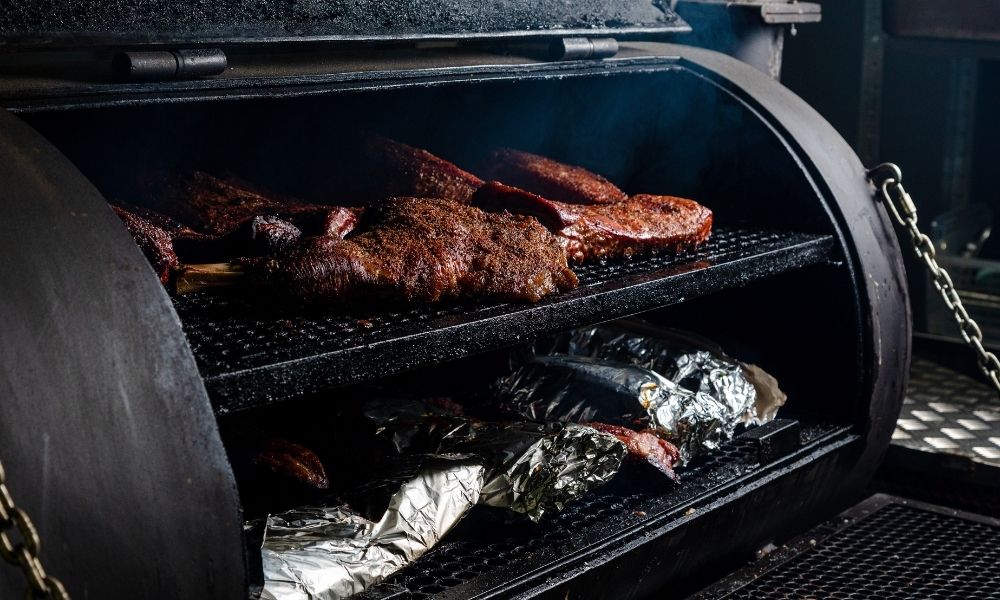No matter the season, it’s entirely possible to make a delicious home-cooked brisket for the whole family. Regardless of the event, a quality, properly cooked is sure to be the star of any dinner. This dish is often served Texas-style at community or family barbecues or paired with a fruity, sweet sauce during the holiday season.
So how do you correctly prepare a memorable, rich brisket meal? Most simply, it comes down to detailed preparation, adequate seasoning, and patient cooking methods. For a more detailed explanation, check out this pitmaster’s guide to grilling and how to smoke beef brisket to perfection.
Using a Smoker
The most straightforward method of smoking any kind of meat is using a smoker. These are outside appliances that cook meat over long periods of time at low temperatures. Their tube-like shape stays sealed so that the smoke can infuse with your brisket. This adds a rich flavor and gives your meat a nice texture. Fuel sources include wood, gas, charcoal, pellets, and electricity.
Preparation
You’ll want to ensure that your meat is fully thawed and at room temperature before you throw it in the smoker. This keeps the brisket tender and juicy throughout the cooking process.
Once your meat is in optimal condition, it’s time to trim off the fat and skin. This ensures even cooking and better absorption of smoke. Furthermore, you won’t waste any part of the brisket, saving you money and heartache. Put on a pair of protective gloves, grab a fillet knife, and remove any coverings on the brisket. Starting with the underside of your meat, trim along the grain and remove any fat and skin. Next, remove large chunks of pure fat from the point of your meat by firmly grabbing it and slicing it back and forth. Keep the edges of your brisket uniform and straight while you’re trimming.
To ensure the edges don’t burn, cut along each side of the meat—this is called “squaring off.” Once you’ve finished all these steps, go back and check for any missed areas. Lastly, flip the brisket over and trim the fat cap to around a fourth of an inch—leaving more makes for a crispier outer layer, but the brisket won’t cook as uniformly.
Next, your brisket is ready for seasoning!
Seasoning
The perfect seasoning for your brisket mostly depends on the style of food you’re serving at your event or dinner. Always use a generous amount of kosher salt and ground black pepper for any occasion. For a robust summery flavor, garlic and onion powder work best. For a Tex-Mex dish, opt for fajita seasoning and granulated garlic. If you’re serving brisket in the winter, marinate your brisket overnight in a mixture of herbs, cola, olive oil, and Worcestershire sauce.
To truly upgrade your brisket meal, consider one of Williams Food Co.’s premier steak seasonings for sale, which feature many of these spices and materials already. Pro tip: always season the edges of your brisket!
The First 5 Hours
Now comes the fun part! Prepare your smoker and place your meat fat cap–side up and adjacent to the fire. Include a piece of wood between the brisket and the fire to act as a “blocking log”—this prevents the tip closet to the heat from burning. Brisket absorbs smoke the most during the first few hours of cooking, so it’s best to keep the temperature low when you’re starting. We recommend around 250 degrees Fahrenheit for optimal results. You can also throw in a water pan to add more humidity to the smoker and reduce burnt edges on your brisket.
After about 5 hours, your brisket should have a nice color, and juice should be pooling around the lean. Turn up the temperature to around 275 degrees Fahrenheit and fill up your water pan. Spritz your meat—along with your blocking log, if it’s starting to smolder—with an apple cider vinegar spray. You can throw leftover beef fat directly into the fire to give your brisket a charred taste. Repeat this step throughout the rest of the cook. Seal up the smoker and check the chimney for clean, colorless smoke—this means your meat is cooking to perfection.
Fun fact: while your brisket cooks, you can spend the time using leftover trim to make burger meat in a grinder for future meals. Additionally, brisket fat is excellent for making beef tallow.
Hours 7 to 10
At around the 7-hour mark, check on your meat. It should have a nice, smoky color and not be burnt on the edges. Spritz the brisket with a Worcestershire spray to add flavor and color. If you notice any especially burnt spots, wrap those areas with foil to protect the meat.
After 8 to 9 hours of cooking, start preparing your butcher’s paper by spritzing it with water—spray generously! Remove your brisket and firmly wrap it in the paper, ensuring it’s completely tucked in. Throw the wrapped meat back into the smoker for an hour or 2, with the lean side to the fire. Afterward, feel for a jiggly texture, which will mean your brisket is almost ready!
The Last Cooking Steps
Rest your brisket on an oven sheet until it reaches around 175 degrees Fahrenheit, and then place it in your oven on its lowest setting. Leave the meat in the oven overnight to ensure maximum flavor and tenderness.
Add your cooked tallow and wrap the meat back up. Place it back in your oven for around 2 hours, and then check that the underside is pliable and jiggly.
Plating
Your long journey is finally over, and your brisket is ready for you to serve it. Let it rest for a little bit until it reaches below 160 degrees Fahrenheit. With a sharp knife, trim it from side to side, creating long strips of juicy meat. You can serve the brisket with a starchy side such as potatoes or cut the pieces smaller for beef brisket sandwiches. Wipe away any messy juices on the plate for an expert presentation. Your meat should be so rich that you’ll have delicious leftovers for days to come!
With this pitmaster’s guide to grilling and how to smoke beef brisket, you’re adequately prepared to make the best meat dish of your life. The cooking process for perfect brisket is long, and it may test your patience. However, a low-and-slow method is the best way to ensure a robust, juicy meal. Eliminate the stress of finding the perfect seasoning by browsing our extensive selection of quality products guaranteed to up the flavor of your brisket.


